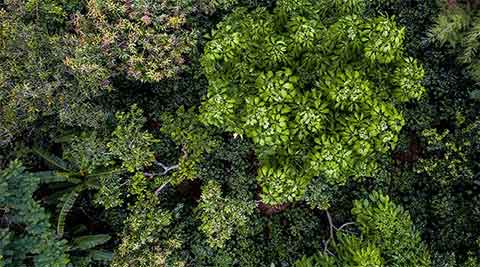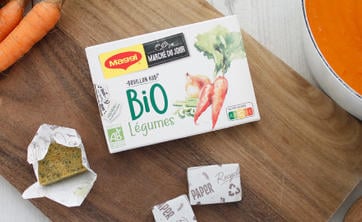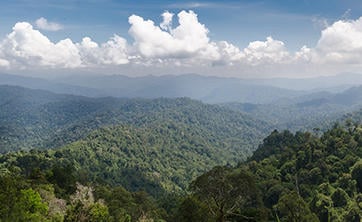Our road to net zero

Climate change is one of society’s greatest challenges. It is also one of the greatest risks to the future of our business. Limiting its severity and impacts requires all of us to act with urgency.
Solutions to the climate crisis and a low-carbon future must be just, addressing human rights and benefiting communities. The majority of our greenhouse gas (GHG) emissions come from our value chain (95%), from activities like land use and farming. That’s why we’re working with partners throughout our value chain to scale up activities such as regenerative farming. We are working to significantly reduce our GHG emissions, even as our company continues to grow.
In 2020, we published the Nestlé Net Zero Roadmap and since then we have transformed our business to start delivering reductions in greenhouse gas emissions across all three Scopes of Nestlé’s activities. We have developed two main strategic approaches that will help tackle our Scope 3 emissions. The Nestlé Forest Positive strategy aims to conserve and restore forests and natural habitats. The Nestlé Agriculture Framework sets out our vision for a more regenerative food and farming system.
Net zero by 2050
What we are doing to reduce emissions
Carbon reductions and removals
To achieve net zero emissions, we need to reduce emissions throughout our business and supply chains.
We collaborate with suppliers, farmers and communities to increase use of regenerative agricultural practices. We are also investing in sustainable logistics, packaging and manufacturing activities, and reducing the risk of deforestation.
Our Net Zero Roadmap includes carbon removals. Natural climate solutions within our supply chain will form a significant part of our decarbonization pathway, removing greenhouse gases from the atmosphere.
These removal projects take place in the landscapes where we source our raw materials and help restore forests, wetlands and peatlands. Our projects can also help generate additional benefits for communities and protect biodiversity and natural ecosystems.
For Scope 1 and 2 emissions, our primary strategy is to reduce our energy consumption and increase the share of renewable energy in our factories and within our logistics activities.
Our net zero roadmap
2018–2021: Our path to regeneration for future generations
Solving the problem means identifying the problem. We found Nestlé emitted 92 million tonnes of greenhouse gas emissions in 2018*. Now we know the extent, we know the road ahead.
Companies and their emissions grow over time. That’s why we’re promising to be net zero based on our 2018 baseline, no matter how much our company grows.
Nestlé’s in-scope GHG emissions by operation million tonnes of CO2e, in 2018
| Scope 3 | ||
|---|---|---|
| Sourcing our ingredients | 65.6 | 71.4% |
| Scope 1, 2 & 3 | ||
| Manufacturing our products | 7.0 | 7.7% |
| Scope 3 | ||
| Packaging our products | 11.0 | 11.9% |
| Scope 3 | ||
| Managing logistics | 7.5 | 8.2% |
| Scope 3 | ||
| Travel and employee commuting | 0.8 | 0.8% |
| Figures have been rounded. | ||
*Total GHG emissions were 113 million tonnes (CO2 equivalent) in 2018, 92 of which are in scope of our UN 1.5°C pledge.
2021–2025: Moving faster
By 2025, we will reduce our emissions by 20%
We’re excited to hit the soil running. We’re accelerating our work in manufacturing, packaging and carbon-neutral brands. We’re also investing CHF 1.2 billion to help spark regenerative agriculture across our supply chain, as part of a total investment of CHF 3.2 billion by 2025.
Our milestones
-
100% deforestation free for primary supply chain by 2022
-
Switch our global car fleet to lower emission options by 2022
-
100% certified sustainable palm oil by 2023
-
100% sourced renewable electricity in all our sites by 2025
-
100% of our packaging recyclable or reusable by 2025
-
100% certified sustainable cocoa and coffee by 2025
-
Source 20% of key ingredients through regenerative agricultural methods by 2025
-
Cut virgin plastic in our packaging by a third by 2025
-
Plant 20 million trees a year
2025–2030: Scaling up
By 2030, we will reduce our emissions by 50%
Further down the greener path, we will invest in new technologies and fundamental changes to our products and businesses around the globe.
Our milestones
-
Use more renewable thermal energy in our manufacturing
-
Source 50% of key ingredients through regenerative agricultural methods by 2030
-
Plant 200 million trees by 2030
2030–2050: Delivering our promise
By 2050, we will reach net zero
Advanced agricultural techniques will deliver a regenerative food system at scale, supported by zero emission logistics and company operations.
We will balance any remaining emissions through high-quality natural climate solutions that benefit people and the planet.
Our roadmap in action
-
We aim to grow 200 million trees by 2030 Learn about our activities to help restore forests.READ MORE

-
Regenerative agriculture: an essential transformation Shifting to regenerative regenerative agriculture practices to grow ingredients for our products helps improve soil health and increases its ability to absorb carbon.READ MORE
-
From renewable electricity to lower emission fleet vehicles See how we are working to reduce emissions across our operations.READ MORE
-
We aim for more than 95% of our packaging to be designed for recycling by 2025 We’re innovating our packaging to reduce emissions and waste.READ MORE
-
Transforming our portfolio We are transforming our portfolio in line with growing consumer demand for products that are good for you and good for the planet.READ MORE
-
Striving for net zero dairy Our large-scale projects in multiple markets aim to demonstrate that dairy has the potential to become net zero.READ MORE
Climate change is now a lived experience, not a future projection. For a company as dependent on agriculture as Nestlé, this matters – greatly – and is why we are so determined to play our part by reaching net zero no later than 2050.












